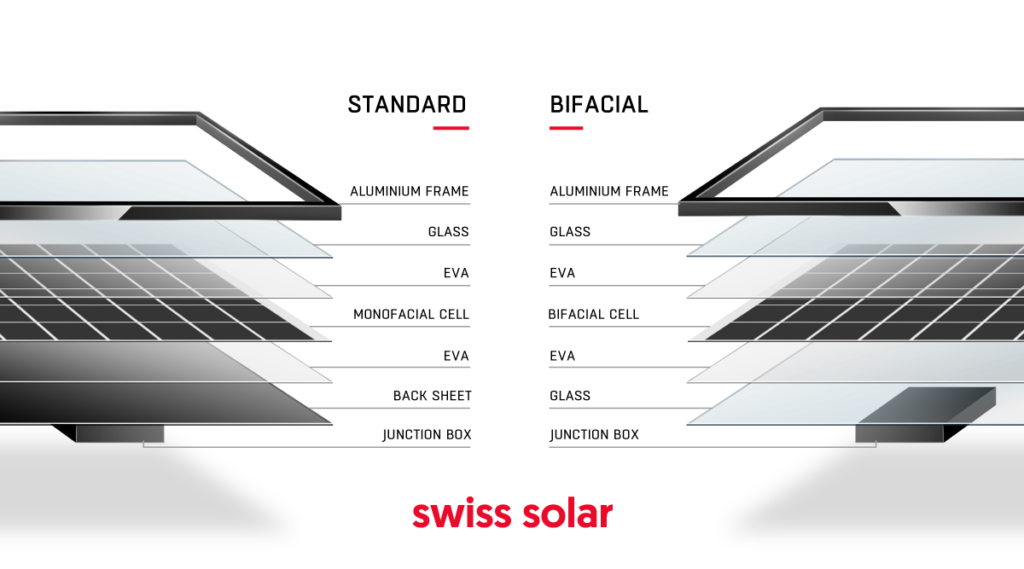Swiss Solar Bifacial Technology
06/07/2021
Swiss Solar continues to expand its international presence, confirming its reputation as a reliable manufacturer and supplier of solar panels for commercial, municipal and individual projects. Using the latest advancements in PV technology to develop its own modules the company moves confidently towards increasing its products capacity, efficiency and quality.
Since 2020, the company completely switched to the production of high-performance monocrystalline modules using PERC technology.
One year later, in 2021, Swiss Solar quit using full cells. Today, all Swiss Solar products are manufactured only on the basis of the half cell technology. Modules assembled from such cells are characterized by:
- low resistive transmission loss;
- higher shading efficiency due to the design solutions (parallel connection of cell strings inside the module);
- durability: small cells are less susceptible to linear expansion when heated.
Another step towards improving Swiss Solar products and increasing their efficiency was the launch of in-house designed bifacial panels.
Combining in their design the mentioned above technologies PERC, Half Cell and Bifacial cell, these modules have shown significant progress in the global PV markets over the past five years. The steady downward trend in the cost of bifacial modules, and hence in the energy they generate, contributes significantly to this success. In 2019, despite minor fluctuations, the cost of production of 1 Wp decreased on average by 9.3%, and in 2020 already by 15.4% and reached 0.33 €/Wp. [1]
What are the differences between bifacial and standard modules? What advantages do bifacial modules have? Why is Swiss Solar planning to expand their production in the near future and eventually increase their share of the total volume to 30%?
Design
As shown in the diagrams in Fig. 1, the first difference between standard and bifacial panels is the design.

Fig. 1: Standard vs. bifacial module
The use of tempered glass instead of an opaque back substrate allows the light not only to pass freely through the module, but also to return to the cells on the back of the module after being reflected from the ground surface. This allows additional energy generation, thus increasing the total power up to 25% compared to standard panels.
Characteristics
In the following table, the monofacial panel IBEX-144MHC-EiGER is compared with the bifacial panel IBEX-144MHC-EiGER-Bifacial.
| Characteristics | IBEX144MHC-EiGER-545 | IBEX-144MHC-EiGER-Bifacial
545 |
| Rated power | 545 | 545 |
| Additional power | None | up to 30% |
| Installation type | on the ground | tracker |
| Cell type | 188 mm2 | 188 mm2 |
| Efficiency | 21.09 % | 21.00 % |
| Dimensions | 2279 x 1134 x 35 mm | 2285 x 1134 x 35 mm |
| Weight | 28.5 kg | 31.6 kg |
Table. 1 IBEX144MHC-EiGER-545 and IBEX-144MHC-EiGER-Bifacial 545 compared
As can be seen in Table 1, the bifacial panels, given the same nominal power, show a significant advantage over the standard ones, which is explained by the additional generation provided by the back side of the module.
It’s important to note that the best performance is achieved with a single-axis tracker, which provides maximum panel illumination throughout the day. Studies prove that bifacial modules with uniaxial tracking system show the lowest LCOE value, which is almost independent of geographical location. Systems with monofacial modules rank second, with a minimum LCOE achieved at 87.9% of the land area (vs. 93.1% for bifacial modules). [2]
If the surface of a bifacial module has the highest albedo value (eg. sand, light concrete) that also contributes to the increase in capacity. As an analysis of Wood Mackenzie’s annual reports shows, it is this factor that led to increased demand for these modules in countries such as Egypt, UAE, Mexico, Brazil and Oman since 2018.
The slight increase in weight compared to the standard module (3.1 kg) does not create difficulties during operation and does not require additional installation costs.
Financial side
The advantages of using bifacial modules are illustrated more clearly by comparing financial indicators. Here is an example of a European country, Poland (Table 2).
| Indicator | IBEX144MHC-EiGER-545 | IBEX-144MHC-EiGER-Bifacial |
| Price | standard | standard + 13% |
| Price for installation construction | standard | standard + 78% |
| Annual generation,
100 kW PV system
|
103501.75 kW h
|
134552.27 kW h
|
| Revenue in EUR
at a rate 0,065 € |
6727,61375 | 8745,89755 |
| Payback period (years) | 6,5 | 6,3 |
Table 2: Financial indicators
Simple calculations show that despite the difference in cost between standard and bifacial panels, the income from using the latter, given the exceptional (25-30 years) durability, provides a guaranteed return on investment (ROI).
The high profitability of projects and the short payback period explain the increased interest of the market in bifacial modules. Wood Mackenzie predicts that, if the current growth rate continues, the total capacity of installed modules by 2024 will exceed the 2020 figure (5.42 GW) by almost four times and reach the mark of 21 GW.
Quality and warranty
Swiss Solar, like all major manufacturers, pays serious attention to the quality of its products. Monitoring of module parameters during the production process and compulsory testing of finished products excludes poor-quality products from reaching the customer. This approach allowed the company to increase the warranty period of their panels up to 30 years (power warranty) and up to 20 years (product warranty). The same warranty is provided for bifacial modules, which already at an early stage of their life cycle have won the trust of customers due to their reliability and quality.
Conclusion
The above analysis confirms the effectiveness of the choice of bifacial modules as a new direction of the company and gives reasons for a significant expansion of their production in the future.
Links
[1] https://www.pv-magazine.com/module-price-index/
[2] https://www.cell.com/joule/pdf/S2542-4351(20)30188-4.pdf